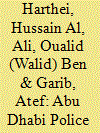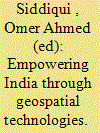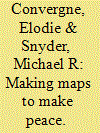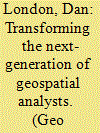|
|
|
Sort Order |
|
|
|
Items / Page
|
|
|
|
|
|
|
| Srl | Item |
| 1 |
ID:
130884


|
|
|
|
|
| Publication |
2014.
|
| Summary/Abstract |
Emergency services such as police vehicles must provide reasonable service levels in order to ensure public safety. These services are typically provided by vehicles based at fixed locations. The number and placement of vehicles generally influences the quality of services offered. Increasing the number of vehicles is often limited by cost constraints; therefore the efficient deployment of such service vehicles is a crucial issue. Emergency service vehicles must be located in such a way that they may reach any demand point within a maximal response time. Current Practices in Abu Dhabi The traffic police in Abu Dhabi perform two major functions: enforcing traffic Abu Dhabi Police Plans laws and assisting road users. Within the Abu Dhabi Police department, the Directorate of Traffic and Patrols, which is in charge of all traffic aspects, allocates the traffic patrol vehicles to routine work and to special operations. The special operations vehicles are involved in escorting convoys and motorcades and in enforcing traffic laws and regulations through the deployment of patrol officers in specific areas at certain times, or in dealing with incidents and special events. The routine patrols perform all remaining tasks. At present, the patrol car allocation process is largely manual and relies heavily on the knowledge, experience and expertise of the dispatch operators. The operators divide the Emirate into geographic zones and allocate patrols based on their knowledge about the areas' needs and other criteria such as traffic flow patterns, population density, etc. In the event of an accident or call for assistance, the dispatcher calls on one of the patrol vehicles nearby and assigns it the task of dealing with the event.
|
|
|
|
|
|
|
|
|
|
|
|
|
|
|
|
| 2 |
ID:
115967


|
|
|
|
|
| Publication |
New Delhi, FICCI, 2013.
|
| Description |
x,208p.
|
|
|
|
|
|
|
|
|
|
|
|
Copies: C:1/I:0,R:0,Q:0
Circulation
| Accession# | Call# | Current Location | Status | Policy | Location |
| 056925 | 551/SID 056925 | Main | On Shelf | General | |
|
|
|
|
| 3 |
ID:
142279


|
|
|
|
|
| Summary/Abstract |
This article analyses how United Nations peacekeeping operations are harnessing geospatial technology, including high-resolution satellite imagery and geographic information systems (GIS), in the furtherance of peace and security. We argue that it is strengthening the ability of peacekeepers to accomplish their mandated tasks, including the demarcation of international boundaries, support for the negotiation of peace agreements, stabilization, the protection of civilians, human rights monitoring, electoral assistance, support for the extension of state authority and the provision of humanitarian assistance. However, it remains to be seen how and to what extent UN peacekeeping can continue to grow and expand its geospatial capabilities. We identify several challenges of an operational and political nature that tend to impede its utilization. A key question in this regard is whether politics will prevent peacekeepers from exploiting recent advances in geospatial technology. We conclude and synthesize our argument by developing a simplified framework for determining when and under what conditions peacekeepers can effectively harness geospatial technology.
|
|
|
|
|
|
|
|
|
|
|
|
|
|
|
|
| 4 |
ID:
130883


|
|
|
|
|
| Publication |
2014.
|
| Summary/Abstract |
It's been ten years since the 2004 National Defense Authorization Act was signed, officially coining the term 'GEOINT'. Today, GEOINT has become such a focus of national defence that the supply of analysts simply cannot meet the demand for imagery products. Almost every intelligence report requires, or could be enhanced by, some geospatial imagery component. As a result, geospatial intelligence software companies like ours have been hard at work developing full suites of integrated geospatial products capable of being used by any analyst, anywhere, at any time. Rather than transforming, through retraining, all-source analysts into geospatial experts, with the right tools, we can empower these talented and experienced all-source analysts to easily extract their own imagery to complete their intelligence products, freeing up the geospatial imagery experts to focus their attention on processing and exploiting more complex geospatial data. To do this, we set out to develop a lightweight, intuitive Web-based Electronic Light Table that would enable any all-source analyst to easily locate imagery, maps, vectors or text reports so they can build their daily intelligence reports or briefings.
|
|
|
|
|
|
|
|
|
|
|
|
|
|
|
|
|
|
|
|
|